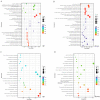Transcriptomic and Metabolomic Profiling Reveals the Variations in Carbohydrate Metabolism between Two Blueberry Cultivars
- PMID: 38203463
- PMCID: PMC10778917
- DOI: 10.3390/ijms25010293
Transcriptomic and Metabolomic Profiling Reveals the Variations in Carbohydrate Metabolism between Two Blueberry Cultivars
Abstract
Blueberry is a high-quality fruit tree with significant nutritional and economic value, but the intricate mechanism of sugar accumulation in its fruit remains unclear. In this study, the ripe fruits of blueberry cultivars 'Anna' and 'Misty' were utilized as experimental materials, and physiological and multi-omics methodologies were applied to analyze the regulatory mechanisms of the difference in sugar content between them. The results demonstrated that the 'Anna' fruit was smaller and had less hardness than the 'Misty' fruit, as well as higher sugar content, antioxidant capability, and lower active substance content. A total of 7067 differentially expressed genes (DEGs) (3674 up-regulated and 3393 down-regulated) and 140 differentially abundant metabolites (DAMs) (82 up-regulated and 58 down-regulated) were identified between the fruits of the two cultivars. According to KEGG analysis, DEGs were primarily abundant in phenylpropanoid synthesis and hormone signal transduction pathways, whereas DAMs were primarily enriched in ascorbate and aldarate metabolism, phenylpropanoid biosynthesis, and the pentose phosphate pathway. A combined multi-omics study showed that 116 DEGs and 3 DAMs in starch and sucrose metabolism (48 DEGs and 1 DAM), glycolysis and gluconeogenesis (54 DEGs and 1 DAM), and the pentose phosphate pathway (14 DEGs and 1 DAM) were significantly enriched. These findings suggest that blueberries predominantly increase sugar accumulation by activating carbon metabolism network pathways. Moreover, we identified critical transcription factors linked to the sugar response. This study presents new understandings regarding the molecular mechanisms underlying blueberry sugar accumulation and will be helpful in improving blueberry fruit quality through breeding.
Keywords: blueberry; fruit quality; glycolysis/gluconeogenesis; pentose phosphate pathway; starch and sucrose metabolism; sugar accumulation.
Conflict of interest statement
The authors declare no conflicts of interest.
Figures








Similar articles
-
Fruit Quality and Metabolomic Analyses of Fresh Food Accessions Provide Insights into the Key Carbohydrate Metabolism in Blueberry.Plants (Basel). 2023 Sep 7;12(18):3200. doi: 10.3390/plants12183200. Plants (Basel). 2023. PMID: 37765362 Free PMC article.
-
Sustained carbon import supports sugar accumulation and anthocyanin biosynthesis during fruit development and ripening in blueberry (Vaccinium ashei).Sci Rep. 2024 Oct 23;14(1):24964. doi: 10.1038/s41598-024-74929-w. Sci Rep. 2024. PMID: 39443596 Free PMC article.
-
Integrative analysis of the transcriptome and metabolome provides insights into polysaccharide accumulation in Polygonatum odoratum (Mill.) Druce rhizome.PeerJ. 2024 Jul 9;12:e17699. doi: 10.7717/peerj.17699. eCollection 2024. PeerJ. 2024. PMID: 39006032 Free PMC article.
-
Combined Metabolome and Transcriptome Analysis Elucidates Sugar Accumulation in Wucai (Brassica campestris L.).Int J Mol Sci. 2023 Mar 2;24(5):4816. doi: 10.3390/ijms24054816. Int J Mol Sci. 2023. PMID: 36902245 Free PMC article.
-
[Sugar transport, metabolism, accumulation and their regulation in fruits].Zhi Wu Sheng Li Yu Fen Zi Sheng Wu Xue Xue Bao. 2004 Feb;30(1):1-10. Zhi Wu Sheng Li Yu Fen Zi Sheng Wu Xue Xue Bao. 2004. PMID: 15583402 Review. Chinese.
Cited by
-
Harnessing de novo transcriptome sequencing to identify and characterize genes regulating carbohydrate biosynthesis pathways in Salvia guaranitica L.Front Plant Sci. 2024 Sep 26;15:1467432. doi: 10.3389/fpls.2024.1467432. eCollection 2024. Front Plant Sci. 2024. PMID: 39391775 Free PMC article.
-
Combined analysis of metabolomics and transcriptomics reveals the effects of sugar treatment on postharvest strawberry fruit quality.BMC Plant Biol. 2025 Jul 4;25(1):882. doi: 10.1186/s12870-025-06919-7. BMC Plant Biol. 2025. PMID: 40615964 Free PMC article.
References
-
- Forney C.F., Qiu S., Jordan M.A., McCarthy D., Fillmore S. Comparison of volatile compounds contributing to flavor of wild lowbush (Vaccinium augustifolium) and cultivated highbush (Vaccinium corymbosum) blueberry fruit using gas chromatography-olfactometry. Foods. 2022;11:2516. doi: 10.3390/foods11162516. - DOI - PMC - PubMed
-
- Su M.-S., Silva J.L. Antioxidant activity, anthocyanins, and phenolics of rabbiteye blueberry (Vaccinium ashei) by-products as affected by fermentation. Food Chem. 2006;97:447–451. doi: 10.1016/j.foodchem.2005.05.023. - DOI
-
- Montecchiarini M.L., Silva-Sanzana C., Valderramo L., Alemano S., Gollán A., Rivadeneira M.F., Bello F., Vázquez D., Blanco-Herrera F., Podestá F.E., et al. Biochemical differences in the skin of two blueberries (Vaccinium corymbosum) varieties with contrasting firmness: Implication of ions, metabolites and cell wall related proteins in two developmental stages. Plant Physiol. Bioch. 2021;162:483–495. doi: 10.1016/j.plaphy.2021.03.016. - DOI - PubMed
MeSH terms
Substances
Grants and funding
LinkOut - more resources
Full Text Sources

